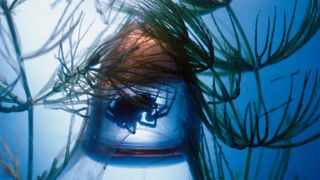
Diving bell spiders create underwater webs that they transfer air from the surface to via hairs on their bodies.
(Image credit: Minden Pictures / Alamy Stock Photo)
Name: Diving bell spider or water spider (Argyroneta aquatica)
Where it lives: Europe and Central and Northern Asia, with a separate subspecies in Japan
What it eats: Other aquatic invertebrates and small fish
Why it’s awesome: As its name suggests, the diving bell spider lives almost completely underwater; it’s the only spider to do so. It still needs to breathe air though, so it survives by creating a diving bell — spinning a web between underwater plants — and then carries air from the surface down to its web via its hairy body.
“It has developed an amazing adaptation for this aquatic life,” Craig Macadam, conservation director of the U.K. invertebrate charity Buglife, told Live Science in an email. “The spider has numerous water-repellent hairs over its body which trap air from the water surface. The spider then spins a silk structure where it forms an air bubble, which it uses in the same way as a diving bell.”
The bubble is expanded until the spider can fit inside. The chambers of females are double the size of those made by males, as they need it to serve as a nursing chamber, too. The air in the diving bell is regularly refreshed, and the spider carries a bubble of water around with it, giving it a silvery coloration.
Unusually for spiders, male diving bell spiders are larger and heavier than females. A 2003 study in the journal Evolutionary Ecology Research looked at why this might be and found that for the more mobile males, growing larger — and having longer front legs — meant they could move more efficiently underwater. By contrast, the size of females was constrained by the need to build a larger air bell in which they look after their young, and the energetic costs associated with more frequently transferring fresh air from the water surface to the bell.
A follow-up study published in 2005 in The Journal of Arachnology by the same authors also revealed an interesting insight into the spiders’ mating behavior: Females appear to prefer mating with large males, despite the hefty risks involved.
The team discovered that larger males occasionally eat the females in a case of reversed sexual cannibalism. However, their experiments also showed that large males and females would also kill small males.
Get the world’s most fascinating discoveries delivered straight to your inbox.
Megan Shersby is a naturalist, wildlife writer and content creator. After graduating from Aberystwyth University with a BSc (Hons) degree in Animal Science, she has worked in nature communications and the conservation sector for a variety of organisations and charities, including BBC Wildlife magazine, the National Trust, two of the Wildlife Trusts and the Field Studies Council. She has bylines in the Seasons anthologies published by the Wildlife Trusts, Into The Red published by the BTO, and has written for the BBC Countryfile magazine and website, and produced podcast episodes for its award-winning podcast, The Plodcast.
>>> Read full article>>>
Copyright for syndicated content belongs to the linked Source : Live Science – https://www.livescience.com/animals/spiders/diving-bell-spider-the-only-aquatic-arachnid-that-creates-a-web-underwater-to-live-in































